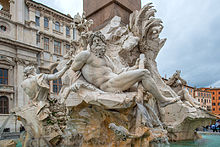Piazza Navona
Coordinates: 41°53′56″N 12°28′23″E / 41.89889°N 12.47306°E / 41.89889; 12.47306

Fountain of the four Rivers with Egyptian obelisk, in the middle of Piazza Navona

Fountain of the four Rivers on Piazza Navona
Piazza Navona (pronounced [ˈpjattsa naˈvoːna]) is a square in Rome, Italy. It is built on the site of the Stadium of Domitian, built in the 1st century AD, and follows the form of the open space of the stadium.[1] The ancient Romans went there to watch the agones ("games"), and hence it was known as "Circus Agonalis" ("competition arena"). It is believed that over time the name changed to in avone to navone and eventually to navona.
Contents
1 History
2 Other monuments
3 Literature and films
4 Vandalism
5 Notes
6 References
7 External links
History

Fontana dei Quattro Fiumi on Piazza Navona 2013
Defined as a public space in the last years of 15th century, when the city market was transferred there from the Campidoglio, Piazza Navona was transformed into a highly significant example of Baroque Roman architecture and art during the pontificate of Innocent X, who reigned from 1644 until 1655, and whose family palace, the Palazzo Pamphili, faced the piazza. It features important sculptural and creations: in the center stands the famous Fontana dei Quattro Fiumi or Fountain of the Four Rivers (1651) by Gian Lorenzo Bernini, topped by the Obelisk of Domitian, brought in pieces from the Circus of Maxentius;[2] the church of Sant'Agnese in Agone by Francesco Borromini, Girolamo Rainaldi, Carlo Rainaldi and others; and the aforementioned Pamphili palace, also by Girolamo Rainaldi, that accommodates the long gallery designed by Borromini and frescoed by Pietro da Cortona.[3]

Piazza Navona Flooded by Antonio Joli. Circa 1760
Piazza Navona has two other fountains. At the southern end is the Fontana del Moro with a basin and four Tritons sculpted by Giacomo della Porta (1575) to which, in 1673, Bernini added a statue of a Moor, wrestling with a dolphin. At the northern end is the Fountain of Neptune (1574) also created by Giacomo della Porta; the statue of Neptune, by Antonio Della Bitta, was added in 1878 to create a balance with La Fontana del Moro.
During its history, the piazza has hosted theatrical events and other ephemeral activities. From 1652 until 1866, when the festival was suppressed, it was flooded on every Saturday and Sunday in August in elaborate celebrations of the Pamphilj family. The pavement level was raised in the 19th century, and in 1869 the market was moved to the nearby Campo de' Fiori. A Christmas market is held in the piazza square.

Piazza Navona by Paolo Salvati oil painting on the table, 1962
Other monuments
- Stabilimenti Spagnoli
- Palazzo de Cupis
- Palazzo Torres Massimo Lancellotti
- Church of Nostra Signora del Sacro Cuore
- Palazzo Braschi (Museo di Roma)
- Sant'Agnese in Agone
Literature and films

- The piazza is featured in Dan Brown's 2000 thriller Angels & Demons, in which the Fontana dei Quattro Fiumi is listed as one of the Altars of Science. During June 2008, Ron Howard directed several scenes of the film adaptation of Angels & Demons on the southern section of the piazza.
- The piazza is featured in several scenes of director Mike Nichols' 1970 adaptation of Joseph Heller's novel, Catch-22.
- The Fontana dei Quattro Fiumi was used in the 1990 film Coins in the Fountain. The characters threw coins into the fountain as they made wishes. The Trevi Fountain was used in the 1954 version of the film.
- It is featured in National Lampoon's European Vacation
- In the 1964 Italian comedy film Yesterday, Today and Tomorrow ("ieri, oggi, domani") Sophia Loren's character Mara lives in a second-floor apartment overlooking Piazza Navona in Rome.
- The piazza is featured in Eugene Levy's film, Once Upon A Crime.
Vandalism
In the early hours of 3 September 2011, the Fontana del Moro was damaged by a vandal. Police later found the man, who had been captured on security cameras climbing in the fountain, wielding a large rock and decapitating some of the larger and smaller figures, after they recognised him by his sneakers.[4][5]
Notes

View of Piazza Navona by Hendrik Frans van Lint, c. 1730
^ Roth, Leland M. (1993). Understanding Architecture: Its Elements, History and Meaning (First ed.). Boulder, CO: Westview Press. p. 233. ISBN 0-06-430158-3..mw-parser-output cite.citation{font-style:inherit}.mw-parser-output .citation q{quotes:"""""""'""'"}.mw-parser-output .citation .cs1-lock-free a{background:url("//upload.wikimedia.org/wikipedia/commons/thumb/6/65/Lock-green.svg/9px-Lock-green.svg.png")no-repeat;background-position:right .1em center}.mw-parser-output .citation .cs1-lock-limited a,.mw-parser-output .citation .cs1-lock-registration a{background:url("//upload.wikimedia.org/wikipedia/commons/thumb/d/d6/Lock-gray-alt-2.svg/9px-Lock-gray-alt-2.svg.png")no-repeat;background-position:right .1em center}.mw-parser-output .citation .cs1-lock-subscription a{background:url("//upload.wikimedia.org/wikipedia/commons/thumb/a/aa/Lock-red-alt-2.svg/9px-Lock-red-alt-2.svg.png")no-repeat;background-position:right .1em center}.mw-parser-output .cs1-subscription,.mw-parser-output .cs1-registration{color:#555}.mw-parser-output .cs1-subscription span,.mw-parser-output .cs1-registration span{border-bottom:1px dotted;cursor:help}.mw-parser-output .cs1-ws-icon a{background:url("//upload.wikimedia.org/wikipedia/commons/thumb/4/4c/Wikisource-logo.svg/12px-Wikisource-logo.svg.png")no-repeat;background-position:right .1em center}.mw-parser-output code.cs1-code{color:inherit;background:inherit;border:inherit;padding:inherit}.mw-parser-output .cs1-hidden-error{display:none;font-size:100%}.mw-parser-output .cs1-visible-error{font-size:100%}.mw-parser-output .cs1-maint{display:none;color:#33aa33;margin-left:0.3em}.mw-parser-output .cs1-subscription,.mw-parser-output .cs1-registration,.mw-parser-output .cs1-format{font-size:95%}.mw-parser-output .cs1-kern-left,.mw-parser-output .cs1-kern-wl-left{padding-left:0.2em}.mw-parser-output .cs1-kern-right,.mw-parser-output .cs1-kern-wl-right{padding-right:0.2em}
^ Edward Chaney, "Roma Britannica and the Cultural Memory of Egypt: Lord Arundel and the Obelisk of Domitian", in Roma Britannica: Art Patronage and Cultural Exchange in Eighteenth-Century Rome, eds. D. Marshall, K. Wolfe and S. Russell, British School at Rome, 2011, pp. 147–70
^ Today the Palazzo Pamphili is the Brazilian Embassy in Rome
^ Vogel, Carol (5 September 2011). "Vandals, or at Least One, Sack a Roman Fountain". New York Times.
^ Willey, David (4 September 2011). "Rome monuments attacked by vandals". BBC. Retrieved 25 December 2013.
References
Norwich, John Julius, ed. (1988). The World Atlas of Architecture. New York: Portland House. p. 302. ISBN 0-517-66875-0.
Rendina, Claudio, ed. (2003). La Grande Enciclopedia di Roma (in Italian) (2nd ed.). Rome: Newton & Compton. ISBN 88-8289-316-2.
Roth, Leland M. (1993). Understanding Architecture: Its Elements, History, and Meaning. Boulder, CO: Westview Press. p. 233. ISBN 0-06-430158-3.
External links
| Wikimedia Commons has media related to Piazza Navona. |
"Bird's eye view of Piazza Navona". Live Search Maps.
- Virtual Tour of Piazza Navona
- Bernini Fountains Video Introduction
- High-resolution 360° Panoramas and Images of Piazza Navona | Art Atlas